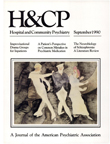Neurobiology of Schizophrenic Syndromes
Abstract
The development of imaging technologies for investigating the living human brain has expanded knowledge about schizophrenia and is providing dues about biological factors associated with the disorder. Drawing on these and other developments in the last two decades, the authors review selected structural, functional, neurochemical, immunological, and infectious factors associated with the schizophrenic syndrome. Many of the biological alterations reported have also been found in other psychiatric, neurological, and medical conditions; therefore, the findings have little specificity for schizophrenia and in fact support the heterogeneity of the disorder. Compilation of this review was supported in part by the U.S. Department of Energy under contract DE-Ac02 76H00016, as part of PET studies of schizophrenia. The authors thank Charles L. Bowden, M.D., chief of the division of biological psychiatry at the University of Texas Health Science Center at San Antonio, for his useful suggestions on the manuscript.
Access content
To read the fulltext, please use one of the options below to sign in or purchase access.- Personal login
- Institutional Login
- Sign in via OpenAthens
- Register for access
-
Please login/register if you wish to pair your device and check access availability.
Not a subscriber?
PsychiatryOnline subscription options offer access to the DSM-5 library, books, journals, CME, and patient resources. This all-in-one virtual library provides psychiatrists and mental health professionals with key resources for diagnosis, treatment, research, and professional development.
Need more help? PsychiatryOnline Customer Service may be reached by emailing [email protected] or by calling 800-368-5777 (in the U.S.) or 703-907-7322 (outside the U.S.).



